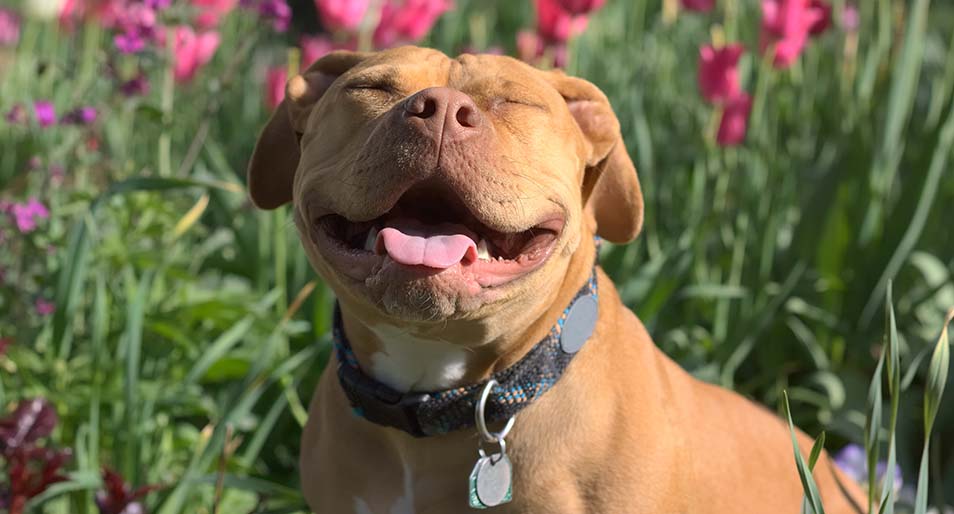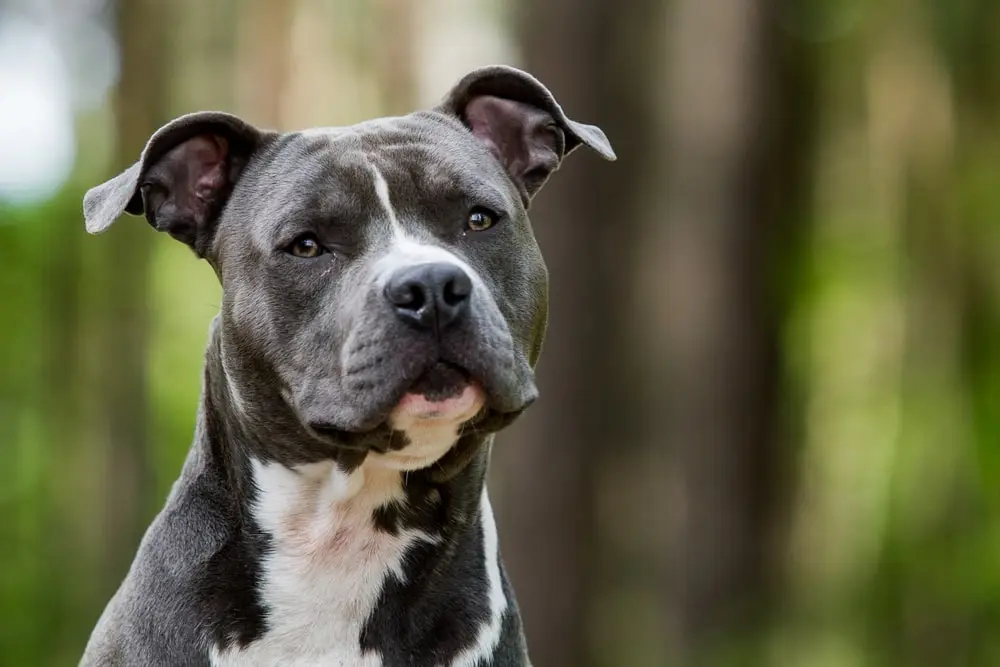BREED SPOTLIGHT
Breed Spotlight: Pit Bull
Pit Bull Quick Stats
LIFESPAN:
12 – 16 years
WEIGHT:
30 – 60 lbs
HEIGHT:
17 – 22 inches
DO I SHED?
Yes, moderately
Personality:
Good-natured, intelligent, fun-loving, and confident
Common Health Problems:
Retinopathy, atopic dermatitis, hip dysplasia, and heart disease
What Is a Pit Bull?
It is important to understand that much confusion exists surrounding this dog. The term “pit bull” originated in the early 1800, referring to five bully breeds: the English bull terrier, the American bulldog, the boxer, the American pit bull terrier, and the American Staffordshire terrier (AmStaff).2
This group shares common characteristics including broad jaws, large heads, compact bodies, and short legs. The American pit bull terrier isn’t recognized by the American Kennel Club (AKC) as a breed, but our fellow dog lovers across the pond, the United Kennel Club (UKC), officially recognize it3 as do various U.S. pitbull organizations.
If you’re interested in getting a pit bull, you may find it helpful to lean on these organizations and rescues that specialize in bully breeds. Professionals working at these places can help you find an American pit bull terrier (or another bully breed) that you’ll fall in love with.
American Pit Bull Terrier: How Do I Look?
The standard American pit bull terrier is a medium-sized dog, standing roughly up to 22 inches at the shoulders, and can weigh up to 60 pounds.3 For more context, a male AmStaff only reaches about 19 inches at the shoulders. American pit bulls are muscular, athletic dogs who love to run and play well into adulthood. Pittie parents love their distinct, wide jaws and high cheekbones that frame their pretty round eyes. Along with their short ears, this gives them a playful expression as they go about their day.
Coat Type and Colors
American pit bull terriers’ coats are short, glossy, and stiff to the touch. As a result, their coats are low maintenance and beautiful to look at. You can find pits with fabulous coat combinations in colors like:4
- Black
- Blue
- Brown
- Cream
- Fawn
- Liver
- Red
- White
Keep your eyes out for unique markings around their eyes or coat patterns, such as brindle and pied. You may stumble across a beautiful dog that will impress everyone at the dog park.
Drooling Level
Pits aren’t known for drooling, but some individual dogs do. If your pit is drooling heavily, it could be a sign of periodontal disease, so pay attention to their behavior and consult your veterinarian.
Ears
The natural shape of an American pit bull terrier’s ear should be a rose (bat wing-like) or half-prick (half erect) shape. Some pit bulls have cropped ears, making their ears stay erect, but this practice is illegal in most countries and U.S. municipalities. Sadly, you may stumble across cropped ears at dog rescues and shelters due to people cropping their ears to make them look more fierce for dog fights.
Shedding and Grooming
Unless your pup is especially messy, a pit bull’s short coat requires little grooming. Barring getting into the dirt, they tend to require a bath once or twice a year along with a weekly brushing session. Their natural oils keep their skin and coat healthy, so invest in a quality slicker brush to keep them looking their best.
Pit bulls can develop skin disorders because of how short their coats are. Be mindful not to use harsh chemicals, human shampoos/soaps, or essential oils. If you aren’t careful, you may have to spend extra dollars on keeping rashes at bay. A dog insurance policy can help you protect their skin if it needs to be treated with ointments or a special shampoo.
American Pit Bull Terrier: Personality Traits
What My Adoption Bio Would Say:
I love balls, open fields, and chew toys but I promise there’s room in my heart for you. Do you like walks? I love walks. Let’s go walk together forever!
Behavior
As a member of the bully breed class, the American pit bull terrier is an active and fun-loving dog. Your average American pit bull is eager to please but can be prone to mischief when bored. Some pittie parents report that their dogs are goofy dogs, who enjoy making their human companions laugh.Most American pit bull terriers’ temperaments lean toward friendly but some struggle with sudden changes in their environment. They will need a patient pet parent who is willing to train them well.
Exercise Needs
Are you looking for a puppy for life? If so, then this is the breed for you. The American pit bull terrier is a high-energy breed that needs at least an hour of exercise a day. They’ll enjoy a fenced backyard where they can safely play fetch or run through make-shift dog courses. Expect to spend hours of fun times with your pittie well into their golden years.
Good with Other Pets?
Some pit bulls may not get along with other pets, so you’ll have to do some homework. Ask the shelter or foster family about the personality of your future pet. A puppy can be socialized to not fear other dogs but, if you get an adult dog, you may have to invest time in training.
Be sure to keep them on-leash in public situations to avoid potential dog scuffles. Pet parents should research breed-specific legislation that exists in their areas before heading out to public spaces.
Trainability
Your pit bull should be prepared and socialized with people and other animals as early as possible. Pits can be a bit stubborn and coupled with their strength, your pittie can become hard to handle if he does not realize that you are the one in charge. Pit bulls are very smart and learn commands quickly with positive reinforcement methods.
Good with Kids?
Despite the bad press, pit bulls make great family pets. Nicknamed “The Nanny Dog,” the pit bull is known for its kindness to children and quickly becomes part of the family. As with any dog, pitties should be trained and supervised by adults when they are with small children. If you get a puppy, socialize your dog as early as possible with your kids. Make sure to be patient while your children learn to respect their new four-legged family member and play gently with them.
Barking Level
American pit bull terriers are average barkers. Some are more vocal than others, depending on how anxious they are and their breeding. Many vocalize less when they are being engaged by their loving family. If you need a less vocal dog, this breed may not be for you.
Are pit bulls dangerous?
Sadly, some American pit bull terrier breeders use these dogs for bull baiting and dog fighting — the source of the name “pit bull.” Now, folks view the breed as dangerous dogs or violent. However, genetics isn’t everything. ASPCA argues that responsible dog ownership is key to making sure a doesn’t harm people or other animals.5
Pit fighting is illegal in many states because it’s inhumane and causes physiological damage to dogs. Kind humans are fighting to change the image of pit bulls, even dedicating October as National Pit Bull Awareness Month. A pit bull in your home that is loved and cared for shouldn’t behave aggressively. They’ll reward your affection with loyalty you can’t put a price tag on.
Common Pit Bull Mixes
Looking for a cute pittie mix? You will find no shortage of mixes out there but here are some popular ones to start your search:
- Beagle bull: This is a mix between a beagle and a pit bull.
- Pitador: This is a mix between a Labrador retriever and a pit bull.
- Pug pit: This is a mix between a pug and a pit bull.
- Box bull: This is a mix between a boxer and a pit bull.
- Pithuahua: This is a mix between a chihuahua and a pit bull.
Common Pit Bull Health Problems
A healthy pit bull’s life expectancy is roughly 12 to 16 years, so you can count on a lifelong companion. Some American pit bull terriers may experience a variety of health issues, including:4
- Allergies
- Atopic dermatitis
- Congenital heart disease: These are inherited heart disorders, including valve malformation.
- Hip dysplasia: This is a defect in the hip joint that makes the ball and socket grind against the pelvic bone.
- Hypothyroidism: This is an abnormality in the thyroid that reduces a dog’s metabolism.6
- Retinopathy: This is a catch-all term that describes the progressive breakdown or atrophy of the retina.
While pits are generally healthy animals, poor breeding practices can result in an unhealthy litter. Be careful when purchasing a pit bull puppy. If you’re adopting, opt for genetic testing to determine what your dog may have inherited from their parents.
Protect your Pets
Even the healthiest of pups can come with unexpected vet costs. Pet insurance can help keep your dog and your bank account happy.
How Pet Insurance Can Help Your Pit Bull
A pit bull is a lifelong friend who will need plenty of play time and veterinary care. Your pit may develop allergies or experience hip dysplasia as they grow into adulthood. As you prepare your loving home for your new pup, don’t forget to add dog insurance to your back pocket. A MetLife dog insurance policy may help cover the cost of diagnosis or treatment of common illnesses, such as atopic dermatitis and retinopathy.1
Retinopathy
Retinopathy is a medical term to describe the breakdown (or atrophy) of the eye’s retina. Diabetes can cause atrophy of the eye in American pit bull terriers but, sometimes, these dogs may have inherited the disorder from their parents. This disorder usually presents itself in puppyhood so it can be caught early before it develops into blindness.7
With how pet insurance works, congenital diseases can be covered by Metlife. It’s a good idea to get a policy while your pittie is a puppy, before something becomes a preexisting condition. Get started today with a free quote from MetLife Pet Insurance, winner of the “Pet Insurance of the Year” Award in the 2024 Pet Independent Innovation Awards Program.8






